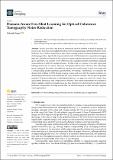Domain-Aware Few-Shot Learning for Optical Coherence Tomography Noise Reduction
Author(s)
Pereg, Deborah
Downloadjimaging-09-00237-v2.pdf (26.56Mb)
Publisher with Creative Commons License
Publisher with Creative Commons License
Creative Commons Attribution
Terms of use
Metadata
Show full item recordAbstract
Speckle noise has long been an extensively studied problem in medical imaging. In recent years, there have been significant advances in leveraging deep learning methods for noise reduction. Nevertheless, adaptation of supervised learning models to unseen domains remains a challenging problem. Specifically, deep neural networks (DNNs) trained for computational imaging tasks are vulnerable to changes in the acquisition system’s physical parameters, such as: sampling space, resolution, and contrast. Even within the same acquisition system, performance degrades across datasets of different biological tissues. In this work, we propose a few-shot supervised learning framework for optical coherence tomography (OCT) noise reduction, that offers high-speed training (of the order of seconds) and requires only a single image, or part of an image, and a corresponding speckle-suppressed ground truth, for training. Furthermore, we formulate the domain shift problem for OCT diverse imaging systems and prove that the output resolution of a despeckling trained model is determined by the source domain resolution. We also provide possible remedies. We propose different practical implementations of our approach, verify and compare their applicability, robustness, and computational efficiency. Our results demonstrate the potential to improve sample complexity, generalization, and time efficiency, for coherent and non-coherent noise reduction via supervised learning models, that can also be leveraged for other real-time computer vision applications.
Date issued
2023-10-30Department
Massachusetts Institute of Technology. Department of Mechanical EngineeringPublisher
Multidisciplinary Digital Publishing Institute
Citation
Journal of Imaging 9 (11): 237 (2023)
Version: Final published version